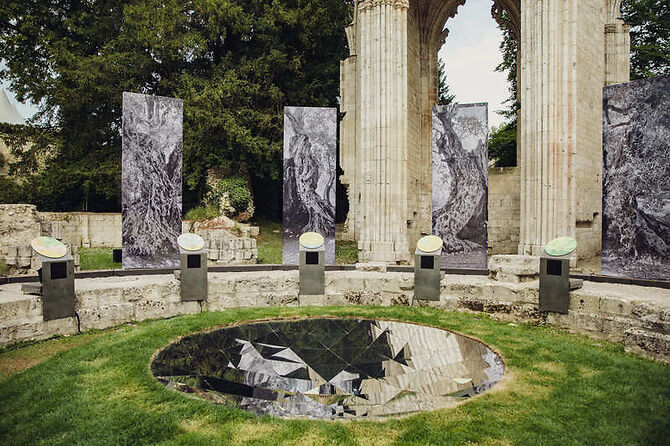
The past in France, Jumièges abbey
Jumièges abbey is worth to be considered the most beautiful testimony of the past in France. The roof has been completely destroyed, but the nave has remained almost untouched. Its height is impressive. Located near the Seine, it was built in the 7th century as a gift from King Clovis to St. Philip. Later it became a Cistercian monastery. It was sacked twice by the Vikings in the late 9th century. But it was recovered by William I of Normandy. Rebuilt by Abbot Robert de Jumièges between 1040 and 1052, it was consecrated in 1067 in the presence of William the Conqueror.
A state property
Between 1267 and 1278 it was transformed in a Gothic style. The community developed rapidly and its library was equipped with about 400 volumes. It was sacked again during the wars of religion in 1562. During the French Revolution, it was acquired as a national property, following the purchase made, in 1795, by Pierre Lescuyer who however demolished the cloister. In 1802 a new owner ordered to destroy the choir. Subsequently, the abbey ran the risk of being totally destroyed. Fortunately, Nicolas Casimir Caumon saved it which later passed into the hands of Lepel-Contret in 1852. He undertook to protect it, perhaps also because Victor Hugo had written that the abbey was “even more beautiful than Tournus”. The writer was echoed by a historian who declared it to be one of the most beautiful ruins in France. In 1947 Jumiège became a state property.

Jumièges, today
Today it hosts exhibitions. For example, various events dedicated to the modern culture of Lebanon were held this year. There was also an installation by the architect Hal Wardé with the collaboration of the poet Etel Adnan entitled “A roof for Silence”. It is a large painted and photographed work called Olivea: homage to the goddess of the olive tree. The trees shown in it are several hundred years old.
This set of works has already been presented at the Venice Architecture Biennale last year. But this set-up is very different and put up outside. It is also enriched by pieces of glass tied to the tragic explosion in the port of Beirout. It seems to me a wrong idea that changes the meaning of the work, restricting it, moreover. Also such intervention destroys a little the artist’s intentional poetry.
Events in Notre-Dame de Jumièges, Lebanon
Despite this useless change, the whole holds up and fascinates. The ruins of the imposing Notre-Dame de Jumièges offer a beautiful setting for this celebration of Lebanon, a country which has suffered from dramatic years between wars and government neglect. The latter fact is at the origin of the recent disaster. There is no possible comparison between the ruins of the church and the works installed (until 6 November). There is only a provisional complementarity. Anyway, the show is worth the trip.
_____________________________________________________________________
L’abbazia di Jumièges è considerata la più bella testimonianza del passato in Francia. Il tetto è completamento distrutto, ma la navata è rimasta quasi integra, e la sua altezza è imponente. Si trova vicino la Senna, lì costruita nel secolo VII. Fu un dono del re Clovis a san Filippo, poi diventato un monastero cistercense. É stata saccheggiata due volte dai Vichinghi alla fine del nono secolo. Ma fu recuperata da Guglielmo I di Normandia. Fatta ricostruire dall’abate Robert de Jumièges tra il 1040 e il 1052, fu consacrata nel 1067 in presenza di Guglielmo il Conquistatore.
Il cambio di proprietà
Nuovi lavori la trasformano all’insegna dello stile gotico tra 1267 et 1278. La comunità si sviluppa rapidamente e la sua biblioteca si dotò di circa 400 volumi. Fu saccheggiata ancora durante le guerre di religione nel 1562. Durante la rivoluzione francese, fu acquisita come bene nazionale, a seguito dell’acquisto fatto da Pierre Lescuyer nel 1795. Ma egli demolì il chiostro. Un nuovo proprietario ordina nel 1802 distrusse il coro. Successivamente, corse il rischio di essere distrutta totalmente. La salvò Nicolas Casimir Caumont. Passò nelle mani di Lepel-Contret nel 1852. Egli si impegnò nel proteggerla, forse anche per via che Victor Hugo aveva scritto che era “ancora più bella che Tournus”. Allo scrittore faceva eco uno storico che dichiarò trattarsi di una delle più belle rovine di Francia. Nel 1947 Jumiège diventa proprietà dello Stato.
Jumièges oggi
Oggi essa ospita delle mostre. Ad esempio, quest’anno sono stati realizzati vari eventi dedicati alla cultura moderna del Libano. Vi è stata allestita anche un’installazione dell’architettto Hal Wardé con la collaborazione della poetessa Etel Adnan avente per titolo “Un tetto per il silenzio” (A roof for Silence). Si tratta di una grande opera dipinta e di fotografie chiamata Olivea: omaggio alla dea dell’olivo. Gli alberi rappresentati sono vecchi di varie centinaia di anni. Questo insieme di opere è già stato presentato alla Biennale Architettura di Venezia l’anno scorso.
Il Libano celebrato a Notre-Dame de Jumièges
Ma questo allestimento è ben diverso e realizzato all’esterno. Inoltre è arricchita da pezzi di vetro provocati dall’esplozione tragica nel porto di Beirut. Mi sembra un’idea sbagliata che cambia il senso dell’opera, restringendolo, peraltro. E poi distrugge un po’ la poesia voluta dell’artista. Malgrado questo intervento inutile, il tutto regge e affascina. Le rovine dell’imponente Notre-Dame de Jumièges offrono un scenario bellissimo per questa celebrazione del Libano aggredito da anni drammatici tra guerre e incuria del governo che è all’origine del disastro recente. Non c’é nessun paragone possibile tra le rovine della chiesa e le opere installate (fino 6 novembre). C’é solo una complementarietà provvisoria. Lo spettacolo vale il viaggio.
Leggi dello stesso autore: Roberto Barni, dentro l’umanesimo







